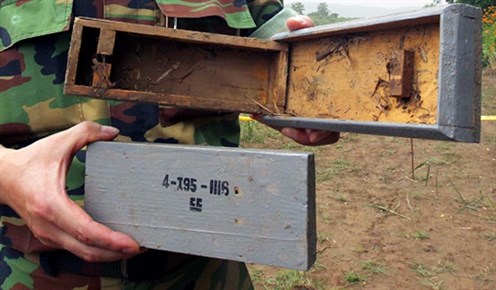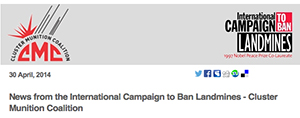24 August 2015
Alleged New Landmine Use by North Korea

North Korean manufactured ‘box landmine’
UPDATE: On 25 August 2015, North Korea expressed ‘regret’ over the mine explosion that injured two South Korean soldiers but it did not admit using the landmines.
---
The International Campaign to Ban Landmines (ICBL) is deeply concerned about allegations of antipersonnel mine use by Democratic People's Republic of Korea (North Korea), calls on all parties to join the Mine Ban Treaty as a confidence building measure.
Two allegations of use by North Korean forces of antipersonnel landmines have occurred since mid-year. In June of this year, South Korea stated that North Korea had started laying new landmines on its borders in order to stop its soldiers from fleeing the country. The ICBL could not verify if this occurred or not, however Korean national campaigners believe official sources cited in the news article were credible.
On 4 August 2015, South Korea alleged that two of its soldiers on a routine patrol on the South Korean side of the demilitarized zone (DMZ) at Yeonchon, in Gyeonggi Province, were injured by three antipersonnel mines newly laid by North Korea. North Korea rejected the allegation.
The type of mine identified was the North Korean wooden box mine has been found frequently in South Korea and on its coastal islands. In 2010 a South Korean man was killed by the same type of mine in the neighboring county in Gyeonggi Province. [see Landmine Monitor report 2011]
However, South Korean officials state that the mines at the place of the incident could not have moved there by water due to terrain, and also assert the area is frequented by their troops. News reports quote Major General Ku Hong-mo of South Korea's Joint Chiefs of Staff said, calling the new use of antipersonnel mines a violation of the 1953 armistice agreement.
South Korea has suffered a large but unknown number of victims of antipersonnel mines, and in 2014, after a decades long struggle by the Korean Campaign to Ban Landmines, the Korean Congress passed a compensation law for landmine victims.
Immediately after the 4 August incident, the US led United Nations Command deployed a Special Investigation Team from the Military Armistice Commission to examine the area. The team included military officers of four countries and was observed by Swiss and Swedish members of the Neutral Nations Supervisory Commission. The investigation concluded “that the North Korean People’s Army violated paragraphs 6, 7 and 8 of the Armistice Agreement by emplacing wooden box land mines along a known Republic of Korea patrol route in the southern half of the Demilitarized Zone, injuring two Republic of Korea soldiers. Additionally, the investigation determined that the devices were recently emplaced, and ruled out the possibility that these were legacy landmines which had drifted from their original placements due to rain or shifting soil.” South Korea has since lodged the incident with the UN Security Council.
Both South and North Korea recommenced broadcast by loudspeaker across the DMZ which had halted over a decade previously, which led to an exchange of artillery and further threats of escalation.
The mine injuries at the DMZ this month, and the allegations which followed, has led to a worrying increase in military tensions between the two Koreas. The US, which has moved closer to the Mine Ban Treaty, stated in 2014 that it will no longer use antipersonnel mines anywhere in the world, except in the DMZ. The ICBL calls on all three states to join the Mine Ban Treaty as soon as possible as a confidence building measure and as an action which could de-escalate the cross border belligerence which has followed the recent mine injuries.


